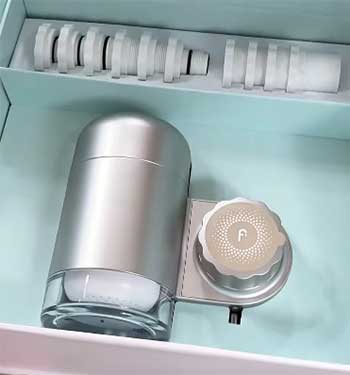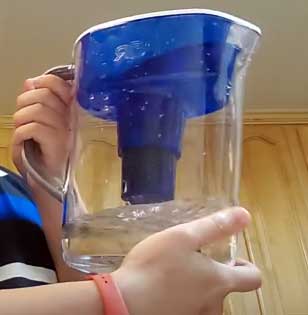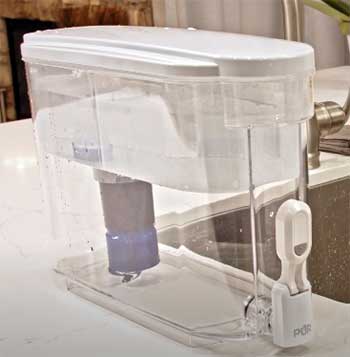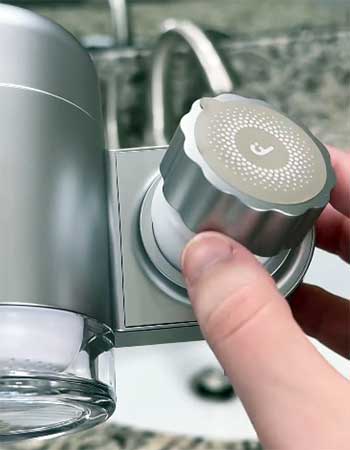I’ve always been particular about the water I use, whether it’s for drinking, cooking, or even washing my face. Lately, I’ve been exploring water filters to ensure my tap water is as clean as possible.
Two brands caught my attention: FilterBaby and PUR. My goal? To figure out which one better suits my needs for safe, clean water. In this article, I’ll compare FilterBaby and PUR, breaking down their pros, cons, and key features from a real user’s perspective.
You’ll get a clear picture to help you decide which filter fits your lifestyle.
A Brief Comparison Table
| Feature | FilterBaby | PUR |
| Filter Type | Faucet-mounted (bathroom sink focus) | Pitcher, dispenser, faucet-mounted |
| PFAS Removal | Up to 99.8% (claimed, not NSF-certified) | 66% (PUR Plus pitcher, EWG-tested) |
| Contaminants Removed | Chlorine, heavy metals, microplastics | Chlorine, lead, mercury, some PFAS |
| Filter Life | 6 months (1,500 gallons) | ~2-4 months (40-100 gallons) |
| Initial Cost | ~$149 (faucet filter) | ~$20-$90 (pitcher/dispenser) |
| Annual Cost | ~$149 (no replacements in first year) | ~$100-$436 (varies by model) |
| Installation | Easy, no tools, universal adapters | Pitcher: none; Faucet: simple screw-on |
| Certifications | Not NSF-certified | NSF 42, 53, 401 (select models) |
| Ease of Use | One-handed operation, sleek design | Pitchers: slow filtration; Faucet: easy |
| Best For | Skin health, bathroom use | Drinking water, budget-conscious users |
My Journey With Water Filters
Water quality has been on my mind a lot lately. I live in a city where the tap water isn’t terrible, but it’s not exactly pristine either. I started noticing my skin acting up—redness, dryness, the works—after washing my face.
Then there’s the drinking water. I want it to taste crisp and be free of anything sketchy, like PFAS or heavy metals.
So, I decided to test two popular options: FilterBaby, a faucet-mounted filter designed with skin health in mind, and PUR, a household name offering pitchers, dispensers, and faucet filters. My mission was to see which one delivers the cleanest water for my needs, from sipping to skincare.
What Is FilterBaby?

FilterBaby is a newer player in the water filtration game, and it’s got a unique angle: it’s designed primarily for bathroom sinks to improve water quality for skincare.
The idea hit home for me because I’d never considered how tap water might be messing with my face.
It’s a faucet-mounted filter, meaning it screws onto your sink’s faucet and filters water as it flows.
The brand claims it removes up to 99.8% of PFAS, chlorine, heavy metals, and microplastics, which sounded promising.
It’s marketed as a premium product, with a sleek design and a focus on protecting your skin from harsh contaminants.
I installed FilterBaby on my bathroom sink, and I’ll admit, the process was a breeze. The kit comes with universal adapters, so it fit my faucet without any hassle.
No plumber needed, no tools—just a quick twist, and I was good to go. The filter promises a six-month lifespan, handling about 1,500 gallons of water, which is impressive compared to other faucet filters I’ve tried. It’s also got a one-handed operation, so I can turn it on while juggling my skincare routine.
But here’s the catch: it’s not cheap, retailing around $149, and it’s not NSF-certified, which made me pause. Certifications are like a seal of trust for me, so I had to dig deeper to see if FilterBaby’s claims held water.
FilterBaby Pros
- Easy Installation: FilterBaby’s setup was a breeze. I had it on my bathroom sink in under five minutes, thanks to the universal adapters that fit my faucet perfectly. No tools, no plumber—just a quick twist, and I was done.
- Long Filter Life: The six-month, 1,500-gallon filter life is a standout. I love not having to swap filters every few months, which saves time and hassle compared to other faucet filters I’ve tried.
- Skin Health Benefits: After a few weeks, my skin felt softer, and the redness I’d been dealing with calmed down. FilterBaby’s focus on removing chlorine and other irritants seems to make a real difference for skincare.
- High PFAS Removal: The claim of 99.8% PFAS removal is a big deal, especially with forever chemicals being a growing concern. Third-party test results back this up, giving me some confidence despite the lack of NSF certification.
- Sleek Design and Usability: The filter looks like a chic bathroom accessory, not a clunky add-on. The one-handed operation is perfect for my skincare routine, making it easy to use while juggling cleansers or towels.
FilterBaby Cons
- High Upfront Cost: At $149, FilterBaby is a big investment. For someone on a tight budget, that price tag feels steep compared to PUR’s more affordable options.
- No NSF Certification: The lack of NSF certification is a red flag. While FilterBaby shares third-party test results, I’d feel better with an industry-standard seal to confirm its contaminant removal claims.
- Limited to Bathroom Use: FilterBaby is designed for bathroom sinks, so it’s not ideal for kitchen tasks like cooking or drinking. If you want filtered water elsewhere, you’ll need another system, which adds cost.
- Replacement Filter Costs: Replacement filters cost about $50 each. While the six-month lifespan helps, heavy water users might need replacements sooner, making long-term costs a consideration.
What Is PUR?

PUR, on the other hand, is a familiar name. I’ve seen their pitchers in friends’ kitchens and their faucet filters in stores.
PUR offers a range of products: pitchers, dispensers, and faucet-mounted filters.
For this comparison, I tested their PUR Plus pitcher (around $30) and their faucet-mounted filter (around $25-$40).
PUR’s big selling point is affordability and accessibility.
Their filters are certified to NSF standards 42, 53, and 401 for select models, meaning they’ve been independently tested to remove contaminants like chlorine, lead, and mercury. Some models claim partial PFAS removal, though not as high as FilterBaby’s bold 99.8% claim.
Setting up the PUR pitcher was as simple as popping in the filter and filling it with water. The faucet filter was equally easy to install—just screw it onto the kitchen faucet.
But I noticed right away that the pitcher’s filtration is slow, taking several minutes to process a full tank. The faucet filter, however, was quick and convenient, delivering filtered water on demand.
PUR’s filters need replacing every two to four months, depending on the model, which can add up over time. I liked the idea of having options—pitcher for drinking, faucet for cooking—but I wondered how they stacked up against FilterBaby’s specialized approach.
PUR Pros

- Affordable Price: PUR’s pitchers start at $20-$30, and faucet filters are $25-$40. This makes PUR accessible for anyone looking to filter water without spending a fortune.
- Product Variety: Whether you need a pitcher for the fridge, a dispenser for a big household, or a faucet filter for cooking, PUR’s range of options lets you pick what fits your lifestyle.
- NSF Certifications: PUR’s NSF 42, 53, and 401 certifications for select models gave me peace of mind. Knowing the filters are tested to remove chlorine, lead, and mercury made me trust the water quality.
- Great Taste: The filtered water from PUR’s pitcher and faucet tasted crisp and clean, rivaling bottled water in my taste tests. It’s perfect for drinking or brewing coffee.
- Wide Availability: Replacement filters are easy to find at most stores, so I never had to worry about running out or ordering online. Convenience is a big plus.
PUR Cons
- Slow Pitcher Filtration: The PUR pitcher’s filtration speed was painfully slow, taking several minutes to fill. It tested my patience when I just wanted a quick glass of water.
- Bulky Design: The faucet filter felt bulky on my kitchen sink, and the pitcher’s dark plastic made it hard to see the water level, which was a minor but annoying design flaw.
- Limited PFAS Removal: PUR’s 66% PFAS reduction (per EWG tests) is decent but falls short of FilterBaby’s claimed 99.8%. If PFAS is a priority, PUR might not be enough.
- Short Filter Life: Filters last 2-4 months (40-100 gallons), meaning frequent replacements. Annual costs can hit $100-$436, depending on the model, which adds up over time.
Key Features of FilterBaby And PUR Comparison

Let’s break down the key features that mattered to me. FilterBaby is a faucet-mounted filter, so it’s all about instant filtration at the point of use.
It’s designed for bathroom sinks, with a focus on removing chlorine, heavy metals, microplastics, and PFAS to protect your skin.
The 1,500-gallon filter life is a standout, and the one-handed operation is super convenient.
But it’s pricey, and the lack of NSF certification is a gamble.
PUR, meanwhile, offers flexibility. The pitcher is great for drinking water, holding 7-30 cups depending on the model, and the faucet filter is perfect for cooking or filling pots.
NSF certifications for chlorine, lead, and mercury are a big plus, and the price is wallet-friendly. However, the shorter filter life and weaker PFAS removal are limitations. The pitcher’s slow filtration and bulky faucet filter design were also minor frustrations.
My Experience With FilterBaby
Installing FilterBaby was a revelation. I followed the brand’s video tutorial, and within minutes, I had clear water flowing from my bathroom sink. The first thing I noticed was how clean the water felt—no chemical smell, no filmy residue.
After a week of washing my face with filtered water, my skin looked brighter, and the redness I’d been battling started to fade. I even used it to fill my water bottle when I was too lazy to go to the kitchen, and the taste was noticeably better than unfiltered tap water.
But I couldn’t shake the price tag. $149 is a lot, especially when I’m already budgeting for other household expenses. And while the third-party tests FilterBaby provides are reassuring, I kept wishing for that NSF seal to fully trust the PFAS claims.
Still, for skincare, it’s been a game-changer, and I love not worrying about what’s in the water touching my face.
My Experience With PUR

The PUR pitcher was my go-to for drinking water. I filled it up, stuck it in the fridge, and had cold, clean water ready to go.
The taste was excellent—crisp, with no weird aftertaste. But the slow filtration was a constant annoyance.
I’d stand there, waiting for the tank to fill, and it tested my patience. The faucet filter was a different story. It was fast, convenient, and perfect for cooking pasta or filling a kettle. Installation was straightforward, though I had to double-check the fit on my pull-down faucet.
The NSF certifications made me feel good about using PUR for drinking, but the 66% PFAS reduction was a letdown. I live in an area where PFAS is a concern, so I wanted stronger protection.
The frequent filter replacements also felt like a chore, especially compared to FilterBaby’s six-month lifespan. Still, for the price, PUR delivered solid value, especially for budget-conscious folks like me.
Which One Is Better?
From an analytical standpoint, the choice between FilterBaby and PUR depends on your priorities. If skincare is your focus, FilterBaby is the clear winner. Its long filter life, high PFAS removal (if the claims hold up), and sleek design make it ideal for bathroom use.
The water feels gentler on my skin, and the results are visible. But the cost and lack of NSF certification are hard to ignore. Without that independent verification, I’m taking a bit of a leap of faith.
PUR, on the other hand, is a practical choice for drinking water. The NSF certifications give it credibility, and the low upfront cost is appealing. It’s versatile, with options for pitchers, dispensers, and faucet filters, so you can tailor it to your needs.
But the weaker PFAS removal and shorter filter life mean it’s not as comprehensive for health-conscious users. If you’re on a budget or don’t need top-tier PFAS protection, PUR gets the job done.
I also considered water waste. FilterBaby’s faucet system doesn’t waste water, as it filters on demand. PUR’s pitcher and faucet filters are similarly efficient, but some PUR models require priming, which uses extra water. For eco-conscious folks, this might tip the scales toward FilterBaby.
Cost Analysis
Let’s talk numbers. FilterBaby’s $149 upfront cost is steep, but with a six-month filter life, you’re not replacing anything in the first year. Annual costs stay around $149, assuming you don’t need a new filter sooner.
Replacement filters cost about $50, so year two could run you $100-$149 depending on usage.
PUR is cheaper upfront. The pitcher costs $20-$30, and the faucet filter is $25-$40. But filter replacements add up. A pitcher filter (40-100 gallons) costs $10-$20 and lasts two to four months, so you’re looking at $30-$120 per year.
The faucet filter, with a 100-gallon lifespan, could cost $80-$160 annually. High-end models like PUR’s dispenser can hit $436 a year with frequent replacements. If you’re budget-focused, PUR wins, but FilterBaby’s lower maintenance might save you in the long run.
Real-World Use Cases
Here’s how I see these filters fitting into daily life. If you’re like me, obsessed with skincare and worried about what tap water is doing to your face, FilterBaby is a no-brainer. It’s perfect for washing your face, brushing your teeth, or even filling a glass in a pinch.
But if your main concern is drinking water—say, for cooking, coffee, or keeping the kids hydrated—PUR’s pitchers and faucet filters are more versatile and budget-friendly. For renters or small households, PUR’s portability is a big win.
If you own your home and want a dedicated bathroom solution, FilterBaby shines.
Frequently Asked Questions (FAQ)
FilterBaby is not NSF-certified but provides third-party test results claiming 99.8% PFAS removal.
Yes, FilterBaby water is safe to drink, removing chlorine, heavy metals, and PFAS, though it’s designed for skincare.
FilterBaby is owned by FilterBaby LLC, a company focused on water filtration for skin health.
FilterBaby claims to remove 99.8% of PFAS, based on third-party testing, but lacks NSF certification.
Wrapping Up
After testing FilterBaby and PUR, I’ve got a clearer picture of what you need to consider. FilterBaby is my pick if you’re prioritizing skincare and want a long-lasting, high-PFAS-removal filter for your bathroom sink.
Its sleek design and visible skin benefits won me over, despite the price and lack of NSF certification.
PUR, though, is your go-to for affordable, versatile drinking water solutions with solid certifications. It’s not perfect for PFAS, but it’s reliable and budget-friendly. You can’t go wrong either way—just choose based on your needs, whether it’s glowing skin or crisp drinking water.
